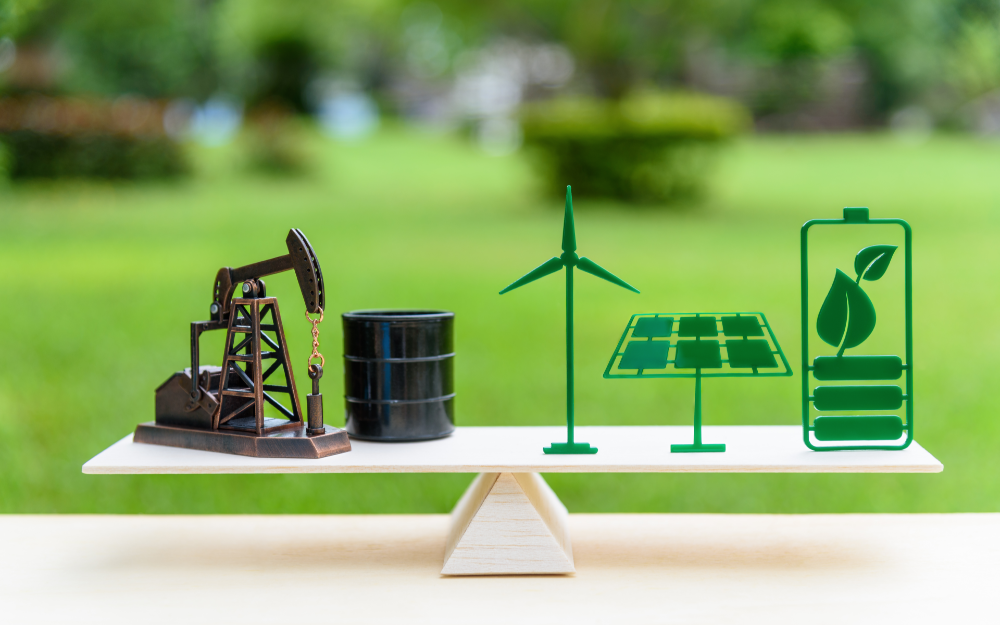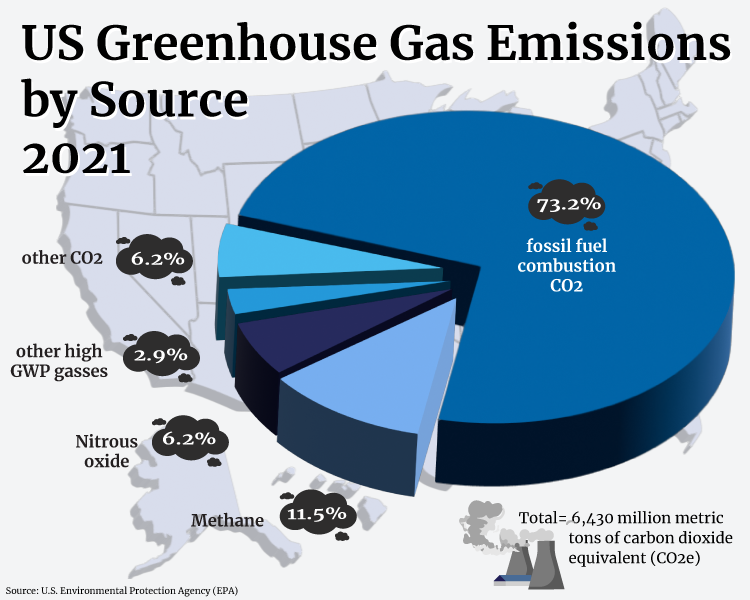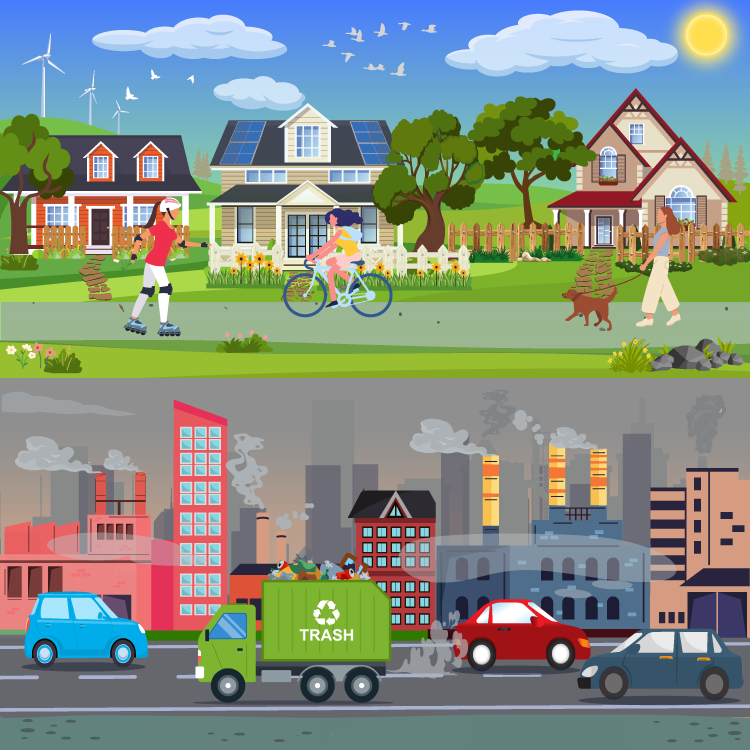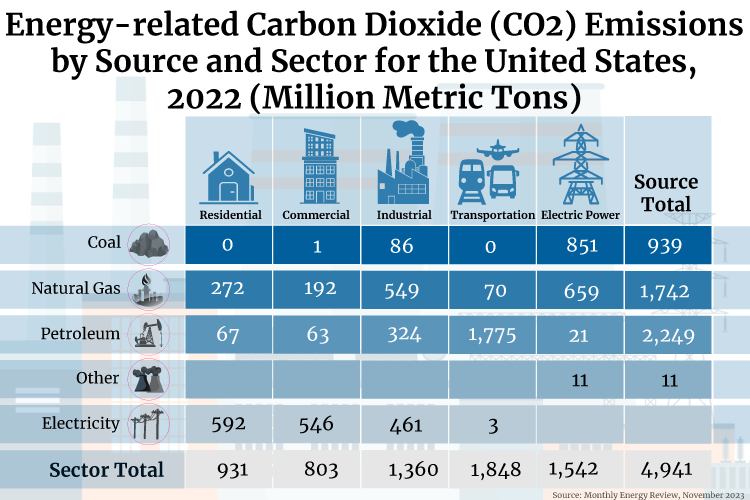
Do you ever wonder what fuels your technology?
Where does the energy that powers the batteries in cell phones come from? How are the batteries made, and what’s the real environmental impact?
Essentially, the answer is usually a combination of factors, including green technology, renewable resources like wind and solar power, or non-renewable fossil fuels extracted from the earth.
All energy sources come with lots of moving parts and adverse impacts on the world, the environment, and individual health.
But what’s the real difference between green energy technologies and fossil fuels? Is there really that big of an impact?
By understanding these elements we can assess the implications of each and explore practical methods that will meet the planet’s energy needs and promote long-term sustainability while minimizing adverse health & environmental effects.
Assessing the Energy Dependency Situation
The global economy is heavily dependent on fossil fuels and that dependency comes with dangers
From extraction and processing to transportation and combustion, each phase of energy generation expels harmful substances such as toxic air, water pollutants, and greenhouse gases.8
According to the EPA, “Fossil fuel combustion (burning) for energy accounted for 73% of the total greenhouse gas emissions in the United States”.1

Public Health Impact of Fossil Fuels
Beyond the immediate ecological consequences, fossil fuel reliance extends to social and economic realms.
Communities residing near extraction sites often carry the brunt of the health issues with marginalized or disadvantaged populations overwhelmingly impacted.
According to the latest data, researchers have learned that more than a quarter million Americans (256,000) are actively residing in places where cancer rates attributed to air pollution surpass the government’s “acceptable” risk threshold.2
The inhabitants of these areas experience higher rates of death due to air pollution-caused illnesses and die in shorter lengths of time. And, sadly, most residents are unaware of the potential health risks they face each day
Many officials label these communities “sacrifice zones”.
Are You Living in an Environmental Sacrifice Zone?
A sacrifice zone is an area of land that has been permanently damaged by environmental or economic disinvestment.
Typically, these are lower-income or minority communities and are considered to be less important economically and are “sacrificed” for the benefit of other areas.
Moreover, in the United States, this is a very imbalanced impact, unequally harming in Black, Brown, Indigenous, and impoverished communities.3
These communities bear the worst of the health issues associated with environmental pollution and economic decline.

Renewable Energy Solutions and Challenges
Renewable energy, often called green energy, comes from harnessing the power of the planet but in a very different way.
- Solar power: Sunlight is harvested with the use of solar panels, converting it into electricity.
- Wind energy: Giant turbines are used to convert motion from the wind into energy.
- Hydroelectric power: The force of flowing water is captured by turbines and converted into energy.
These sources all generate electricity but the key distinction when compared to fossil fuels is that they do so without emitting measurable greenhouse gasses during operations.
This distinction helps mitigate climate change while also reducing air pollution, contributing to cleaner environments and better long-term health for the public, according to officials
Green energy may become a sustainable alternative to fossil fuels someday but there are still many challenges to overcome for it to be the standard.
Challenges to 100% Renewable Energy
While green energy is cleaner and renewable it’s also new and dependent on other factors, like being intermittent and dependent on weather conditions.
Moreover, the emissions generated during the manufacturing and production of these green technologies can limit their carbon neutrality.
Weather inconsistencies require backup sources of large-scale energy storage requiring lots of space, adding to the complexity and overall costs associated with the energy. These backups, generally take the form of batteries.
And, many components in green technology rely on raw materials and manufacturing processes that span multiple countries and continents.
Disruptions that may occur in one part of the world can have cascading effects on the availability and efficiency of production and disposal. Other factors include:
Space and Land Use
To generate power from wind and solar, 10 times as much space per unit of energy produced is required, compared to coal or other fossil fuels.4
For example: wind turbines are ENORMOUS and have an average blade/rotor span of 430 feet (that’s longer than a football field).5
Infrastructure and Technology
The need for new and upgraded infrastructure is critical for integrating renewable energy sources into existing energy systems. Green energy production facilities must be located where the resource is most readily available, not where it’s convenient for society.
Both production and disposal facilities are very limited and concentrated in specific regions.
Ongoing innovation is needed to improve the efficiency and cost-effectiveness of green energy technologies.
Current indicators suggest that the economic costs of green energy are largely ignored.9
Storage and Disposal
A system capable of storing enough energy for California alone would cost more than 2.5 trillion dollars–which pushes the cost of green energy exponentially for the consumer.6
Current storage solutions, such as batteries, face challenges related to capacity, lifespan, and environmental impact
Global Economic Factors
The global supply chain for raw materials used in green technology spans across multiple countries and continents making bilateral cooperation between nations necessary.
Supply and demand are heavily influenced by events around the globe and sudden swings in the market, economic downturns, geopolitical tensions, or pandemics, impact investment.
Head To Head: Impact

Fossil fuels, the long-standing pillar of energy production, are notorious for their detrimental effects on both health conditions and the environment.
The combustion of coal, oil, and natural gas releases vast amounts of greenhouse gasses, primarily carbon dioxide, which significantly contributes to global warming and climate change, posing a severe threat to our planet and to our long-term health.
In 2022, energy-related carbon dioxide emissions for the United States alone were about 4,941 Million metric tons–r.7
Green energy comes with a smaller carbon footprint which is great for the climate crisis and being a cleaner energy source it’s far better for the overall health of humans and animals.
Much of the downsides come from being newer technology and finding the best ways of enhancing efficiency and reliability so the energy can be readily available and relied upon.
The vast amount of land required for the infrastructure to produce, store, and dispose of is also a challenge
The Sustainable Road Ahead
The world is at a crossroads and the shift towards green technologies represents a great option for lowering emissions and improving the lives of people around the world.
By embracing new green technologies and ideas,100% sustainable energy can become a reality in the future.
And, thanks to state solar incentives and other emerging methods, everyone can play a part in its adoption.
References
1U.S. Energy Information Administration. (2023, August 22). Energy and the environment explained. EIA.gov. Retrieved January 30, 2024, from <https://www.eia.gov/energyexplained/energy-and-the-environment/where-greenhouse-gases-come-from.php>
2Zatezalo, Z. (2021, December 6). U.S. “Sacrifice Zones” – Are You Living In One? Bordas and Bordas Attorneys, PLLC. Retrieved January 30, 2024, from <https://www.bordaslaw.com/blog_post/us-sacrifice-zones-are-you-living-one/>
3Donaghy, T. Q., Healy, N., Jiang, C. Y., & Pichon Battle, C. (2023, June). Fossil fuel racism in the United States: How phasing out coal, oil, and gas can protect communities. ScienceDirect. Retrieved January 30, 2024, from <https://www.sciencedirect.com/science/article/pii/S2214629623001640>
4Gross, S. (2020, January). Renewables, land use, and local opposition in the United States. The Brookings Institution. Retrieved January 30, 2024, from <https://www.brookings.edu/articles/renewables-land-use-and-local-opposition-in-the-united-states/>
5Hartman, L. (2023, August 24). Wind Turbines: the Bigger, the Better. U.S. Department of Energy: EERE. Retrieved January 30, 2024, fromhttps:/ <https://www.energy.gov/eere/articles/wind-turbines-bigger-better>
6Temple, J. (2018, July 27). The $2.5 trillion reason we can’t rely on batteries to clean up the grid. MIT Technology Review. Retrieved January 30, 2024, from <https://www.technologyreview.com/2018/07/27/141282/the-25-trillion-reason-we-cant-rely-on-batteries-to-clean-up-the-grid>
7U.S. Energy Information Administration. (2024). FAQs: What are U.S. energy-related carbon dioxide emissions by source and sector? EIA.gov. Retrieved January 30, 2024, from <https://www.eia.gov/tools/faqs/faq.php?id=75&t=11>
8International Tanker Owners Pollution Federation Limited. (2024). Oil Tanker Spill Statistics 2023. ITOPF. Retrieved January 30, 2024, from <https://www.itopf.org/knowledge-resources/data-statistics/statistics/>
9Lesser, J.A. (2023, December 6). The Crippling Economic Costs of Green Energy Subsidies. Manhattan Institute. Retrieved January 30, 2024, from <https://manhattan.institute/article/the-crippling-economic-costs-of-green-energy-subsidies>
